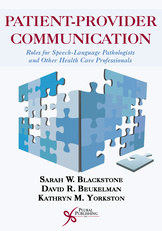Publication
Patient-Provider Communication
Roles for Speech-Language Pathologists and Other Health Care Professionals
- Edited by: Sarah W. Blackstone, David R. Beukelman, Kathryn M. Yorkston
- Details:
- 352 pages, Illustrated (B/W), Softcover, 7 x 10"
- ISBN13:
- 978-1-59756-574-5
- Release Date:
- 04/30/2015
Overview
Patient-Provider Communication: Roles for Speech-Language Pathologists and Other Health Care Professionals presents timely information regarding effective patient-centered communication across a variety of health care settings. Speech-language pathologists, who serve the communication needs of children and adults, as well as professionals from medical and allied health fields will benefit from this valuable resource.
This text is particularly relevant because of changes in health care law and policy. It focuses on value-based care, patient engagement, and positive patient experiences that produce better outcomes. Authors describe evidence-based strategies that support communication vulnerable patients, including individuals who have difficulty speaking, hearing, understanding, seeing, reading, and writing, as well as patients whose challenges reflect limited health literacy, and/or differences in language, culture, religion, sexual orientation, and so on. Topics addressed include patient-provider communication in medical education, emergency and disaster scenarios, doctor's offices and clinics, adult and pediatric acute care settings, rehabilitation, long-term residential care, and hospice/palliative care situations.
The editors are recognized internationally for their work in the field of communication disorders and have been active in the area of patient-provider communication for many years. Patient-Provider Communication is a must-have resource for speech-language pathologists and other health care providers at the forefront of quality patient-centered care.
See related articles in The ASHA Leader March 2016 issue by authors of this book:
What Does the Patient Want? (Blackstone) - read article
Simulating Patient Communication Strategies (Yorkston, Baylor, and Burns) - read article
Words of Preparation for Patients (Burns, Baylor and Yorkston) -
read article
Review
Jane McCann, The University of Queensland, Brisbane, QLD, Australia, International Journal of Disability, Development and Education, Vol 64, No. 6 (2017):
"The authors effectively establish the necessity for improved communication between healthcare providers and patients with communication vulnerabilities. They share research findings, clinical experience and interviews with communication vulnerable patients and their families, and propose how to deconstruct barriers currently exacerbating the gap between educational findings and real-life experiences. They emphasise the importance of time being allocated to healthcare provider teams to raise awareness and influence stakeholders and decision-makers to improve overall patient, family and provider satisfaction through effective communication techniques. The book provides information for all healthcare providers involved in the care of communication vulnerable patients of all ages and in an array of healthcare settings. Case studies abound offering a clearer understanding of situations faced by all involved. This book will provide a valuable resource for all those involved with such patients including medical professionals, students, current carers and family."
Chapter 1. Building Bridges to Effective Patient-Provider Communication
- Sarah W. Blackstone, David R. Beukelman, and Kathryn M. Yorkston
Chapter 2. Issues and Challenges in Advancing Effective Patient-Provider Communication
- Sarah W. Blackstone
Chapter 3. Medical Education: Preparing Professionals to Enhance Communication Access in Health Care Settings
- Kathryn M. Yorkston, Carolyn R. Baylor, Michael I. Burns, Megan A. Morris, and Thomas E. McNalley
Chapter 4. Enhancing Communication in Outpatient Medical Clinic Visits
- Kathryn M. Yorkston, Carolyn R. Baylor, Michael I. Burns, Megan A. Morris, and Thomas E. McNalley
Chapter 5. Integrating Emergency and Disaster Resilience Into Your Everyday Practice
- Sarah W. Blackstone and June Isaacson Kailes
Chapter 6. Adult Acute and Intensive Care in Hospitals
- Richard R. Hurtig, Marci Lee Nilsen, Mary Beth Happ, and Sarah W. Blackstone
Chapter 7. Pediatric Acute and Intensive Care in Hospitals
- John M. Costello, Rachel M. Santiago, and Sarah W. Blackstone
Chapter 8. Patient-Provider Communication in Rehabilitation Settings
- David R. Beukeleman and Amy S. Nordness
Chapter 9. Residential Long-Term Care
- David R. Beukelman
Chapter 10. Enhancing Communication in Hospice Settings
- Lisa G. Bardach
Chapter 11. Making It Happen: Moving Toward Full Implementation
- Sarah W. Blackstone, David R. Beukelman, and Kathryn M. Yorkston
About The Editors
Sarah W. Blackstone, PhD, CCC-SLP, is president of Augmentative Communication, Inc. She has authored multiple texts in the augmentative and alternative communication field as well as articles in Augmentative Communication News and other publications.
David R. Beukelman, PhD, CCC-SLP, is the Barkley Professor of Communication Disorders at the University of Nebraska-Lincoln. He has served as director of research and education for the Communication Disorders Division, Munroe-Meyer Institute for Genetics and Rehabilitation at the University of Nebraska Medical Center.
Kathryn M. Yorkston, PhD, BC-ANCDS, is a professor of rehabilitation medicine and head of the speech pathology division within the Department of Rehabilitation Medicine at the University of Washington Medical Center.
Related Titles
Science of Successful Supervision and Mentorship
331 pages, Illustrated (B/W), Softcover, 6 x 9"
Workplace Skills and Professional Issues in Speech-Language Pathology
392 pages, Illustrated (B/W), Softcover, 6 x 9"
Working with Families in Speech-Language Pathology
Nicole Watts Pappas, Sharynne McLeod
358 pages, Illustrated (B/W), Softcover, 6 x 9"
Telepractice in Speech-Language Pathology
392 pages, Illustrated (B/W), Softcover, 6 x 9"
Supporting Family Caregivers of Adults With Communication Disorders
304 pages, Illustrated (B/W), Softcover, 6 x 9"
Narrative-Based Practice in Speech-Language Pathology
368 pages, Illustrated (B/W), Softcover, 6 x 9"
Augmentative and Alternative Communication in Acute and Critical Care Settings
Richard R. Hurtig, Ph.D., Debora Downey, CCC-SLP
224 pages, Illustrated (B/W), Softcover, 7 x 10"

















